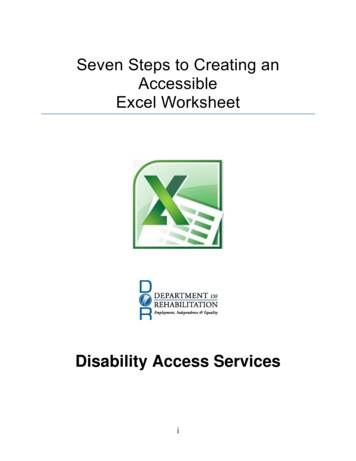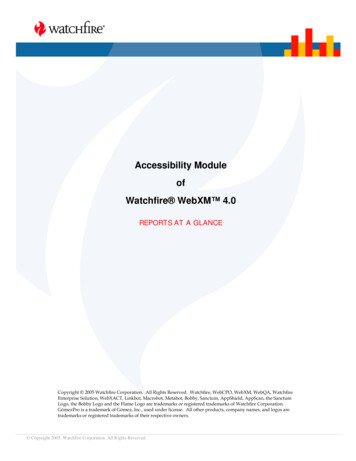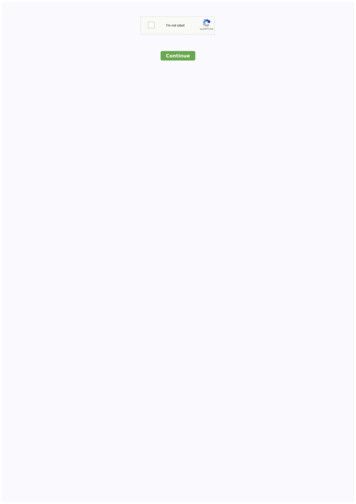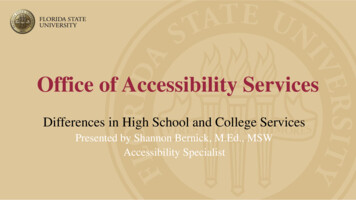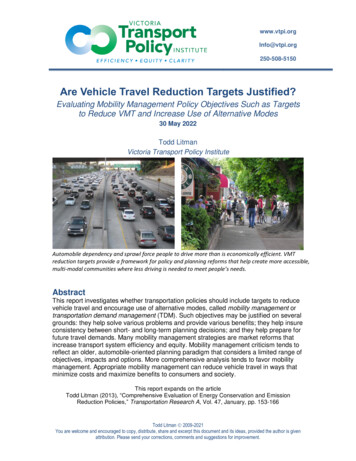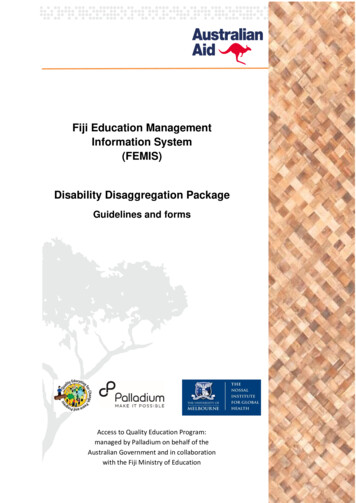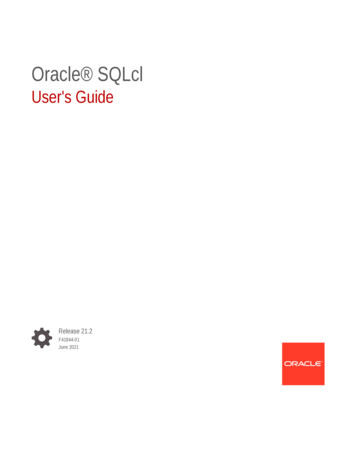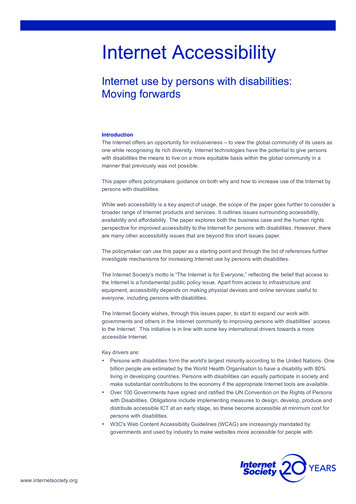
Transcription
Internet AccessibilityInternet use by persons with disabilities:Moving forwardsIntroductionThe Internet offers an opportunity for inclusiveness – to view the global community of its users asone while recognising its rich diversity. Internet technologies have the potential to give personswith disabilities the means to live on a more equitable basis within the global community in amanner that previously was not possible.This paper offers policymakers guidance on both why and how to increase use of the Internet bypersons with disabilities.While web accessibility is a key aspect of usage, the scope of the paper goes further to consider abroader range of Internet products and services. It outlines issues surrounding accessibility,availability and affordability. The paper explores both the business case and the human rightsperspective for improved accessibility to the Internet for persons with disabilities. However, thereare many other accessibility issues that are beyond this short issues paper.The policymaker can use this paper as a starting point and through the list of references furtherinvestigate mechanisms for increasing Internet use by persons with disabilities.The Internet Society's motto is “The Internet is for Everyone,” reflecting the belief that access tothe Internet is a fundamental public policy issue. Apart from access to infrastructure andequipment, accessibility depends on making physical devices and online services useful toeveryone, including persons with disabilities.The Internet Society wishes, through this issues paper, to start to expand our work withgovernments and others in the Internet community to improving persons with disabilities’ accessto the Internet. This initiative is in line with some key international drivers towards a moreaccessible Internet.Key drivers are:www.internetsociety.org Persons with disabilities form the world's largest minority according to the United Nations. Onebillion people are estimated by the World Health Organisation to have a disability with 80%living in developing countries. Persons with disabilities can equally participate in society andmake substantial contributions to the economy if the appropriate Internet tools are available. Over 100 Governments have signed and ratified the UN Convention on the Rights of Personswith Disabilities. Obligations include implementing measures to design, develop, produce anddistribute accessible ICT at an early stage, so these become accessible at minimum cost forpersons with disabilities. W3C's Web Content Accessibility Guidelines (WCAG) are increasingly mandated bygovernments and used by industry to make websites more accessible for people with
disabilities. More governments are starting to incorporate accessibility criteria in their public procurementpolicies.What is accessibility?For persons with disabilities, accessibility means being able to use a product or service aseffectively as a person without a disability. This means using inclusive design principles to makeproducts and services usable by a wider section of the population. In some cases, this is notpossible, and assistive technologies may be called upon to fill the gap. If so, mainstreamtechnologies should enable the software or hardware connection of the assistive deviceseamlessly, in terms of both interoperability and data portability.Changing peoples' attitudes to disability is fundamental to achieving greater accessibility. Thetraditional view of disability is through the medical model, that is, attempting to “fix” or rehabilitatea person to society's norms. The social model of disability aims to dismantle barriers so that aperson with a disability can fully participate in the community. This more contemporary modelemphasises a person's abilities rather than disabilities and encourages a person's independenceand capacity by decreasing environmental barriers.Persons with disabilities face as many different barriers as there are types and degrees ofdisability. For example, people with a visual impairment who use screen-reading software may beconfronted by websites that have confusing navigation, or that lack descriptions of images; whilepeople with a hearing impairment may be unable to participate in online conferencing because itlacks captioning.Through removing barriers, persons with disabilities will be better able to use and contribute to therichness of the Internet by participating independently in the communities of their choice. Whilemaking websites accessible is vital, solutions for accessibility are needed to deliver any product orservice over the Internet and to accept content or services created by persons with disabilitiesregardless of the equipment or medium of input. This includes websites, databases, browsers,multimedia applications, mobile phones, computers and their auxiliary equipment.Apart from accessibility, other barriers need to be overcome so that persons with disabilities cangain benefit from the Internet and contribute value to the Internet. These are:AffordabilityMany persons with disabilities have low incomes and limited educational opportunities. Thisapplies in developed countries and even more in developing countries. Using the Internet isexpensive especially in developing countries. When assistive technologies are required, thebarrier can be even higher.CulturalPersons with disabilities are perceived with pity or shame in many countries. They may berestrictively “protected” by family for any of a number of rationales, ranging from a lack of suitableeducational facilities to a lack of appropriate government services.AvailabilityIn isolated areas, there may be limited availability of the Internet. Encouraging and meeting theneeds of persons with disabilities may be a relatively low priority under such conditions.www.internetsociety.org2
Lack of awareness by community at largePeople in the broader community have limited understanding of how persons with disabilities usetechnology and of the significant benefits the Internet can bring. Making products and servicesaccessible can therefore mistakenly be considered difficult and costly.What is being doneThe Internet Society together with international bodies, governments, regulators, companies, thetechnical community and civil society all have roles to play. In particular, governments and policymakers have an important obligation to use the legislative and regulatory tools at their disposal toaddress accessibility to the Internet for persons with disabilities.The following discussion outlines what is currently happening across all sectors.International bodiesThe United Nations Convention on the Rights of Persons with Disabilities states that access toinformation and communications technologies and systems is one element that will enablepersons with disabilities to participate more fully in all aspects of life. The Convention stipulatesthat governments take appropriate measures for this to occur. Over 100 countries have signedand ratified the Convention, which brings responsibilities, amongst other obligations, to improveaccessibility to the Internet for persons with disabilities. The Convention also states thatinternational cooperation and sharing of resources be done by facilitating access to and sharing ofaccessible and assistive technologies and through the transfer of technologies. Under theOptional Protocol, there are remedies available to persons with disabilities to file complaints underthe UN Convention.The concluding document from the United Nations World Summit on the Information Society, theTunis Agenda for the Information Society, states that for equitable access to occur, attentionshould be given to universal design and promotion of assistive technologies. Universal design orDesign for All is the concept of designing products and services for a wider section of thecommunity based on seven key principles. It has the benefit that products incorporating theseprinciples may be more accessible for persons with disabilities. It also means that devices do nothave to be retrofitted for accessibility but take that into consideration as part of their originaldesign.The Internet Governance Forum (IGF) recognises accessibility to the Internet as a key issue andthrough its Dynamic Coalition on Accessibility and Disability has highlighted steps towards aninclusive society. A simple form of inclusion adopted by the IGF itself is the use of real-timecaptions for its workshop and conference sessions, including online sessions. This is beneficial forpersons from non-English speaking backgrounds but vital for persons with hearing impairment.The standards arm of the International Telecommunication Union, the ITU-T, places significantemphasis on accessibility with regard to particular Study Groups, Questions andRecommendations. In 2008, Resolution 70 was accepted at the World TelecommunicationsStandardization Assembly, highlighting many accessibility standardisation activities includingmechanisms intended to ensure that the needs of persons with disabilities are taken into accountwhen developing all ITU standards and guidelines.www.internetsociety.org3
Governments and regulatorsIn addition to International obligations for national governments to increase accessibility forpersons with disabilities arising from international instruments, national governments andregulatory authorities are taking action. A number of countries have created or modified generalcommunications legislation to include clauses on accessibility. Other countries have createdspecific legislation to promote accessibility. For example, the United States has passed the 21stCentury Communications and Video Accessibility Act of 2010.In some countries, regulatory authorities may use Universal Service Obligation (USO) funds toassist persons with disabilities. These funds usually cover the costs of providing ICT services inrural and remote regions, but they may also have the capacity to incorporate provisions to fundservices for persons with disabilities in all parts of a country. For example, a pilot project usingUniversal Service Obligation funds has started in India to help persons with disabilities to accessICT in rural communities.Another approach at the national level is to incorporate accessibility criteria in ICT publicprocurement processes. Doing so encourages companies that tender for supply of hardware andsoftware to governments to offer products that are more accessible for persons with disabilities inorder to win contracts. The pioneer of this approach was the US Government, through the Section508 guidelines for suppliers. The European Union's Public Procurement Directive includesaccessibility criteria, and under Mandate 376 has directed European standards organisations todevelop an online toolkit to support government agencies in accessible ICT procurement.CompaniesThere is a growing realisation that there is a business case for advancing accessibility to theInternet for persons with disabilities. It is seen as an opportunity to reach into broader consumersegments in a crowded marketplace. This is illustrated by the Business Taskforce on AccessibleTechnology and the OneVoice for Accessible ICT Coalition which surveyed over 300 corporationsin the UK – including Lloyds TSB, KPMG, Virgin Atlantic, BBC, BT and Sainsbury's – to discovertheir views on ICT accessibility. The results from the survey and case studies found that investingin accessible ICT met the following key business goals:123456Reach new marketsMaximise employee engagement and productivityProvision high quality products and servicesImprove supply chain managementBuild partner and community relationsMinimise risk of legal actionFindings from the survey indicate that appointing an “Accessibility Champion” makes a significantdifference at senior management level. Accessibility must not be confined to the IT section of anorganisation; it must become an integral part of all policy and operations. Leadership is vital. Thereport recommends the CEO and the Board communicating “to all employees, suppliers andpartners that provisioning accessible and usable ICTs to all is fundamental to the organisation’score business objectives.”The Business Taskforce on Accessible ICT established an Accessible Technology Charter inNovember 2011. The Charter sets out 10 commitments that corporations should make so thatICT accessibility is embedded throughout the organisation including HR, policy, staff awareness,www.internetsociety.org4
employee workplace adjustments and procurement. There were 17 launch signatories includingCisco, Fujitsu, Microsoft and Oracle.There is potential for market growth in the disability and aged segments if products and servicesare accessible and offered at an affordable price. In Japan, as in many developed countries, themobile phone market is saturated except for those over 50. As people age, they may have hearingloss, vision loss or arthritis and will need more accessible features. NTT has successfully sold 14million Raku Raku phones designed for the older age brackets. Those handsets are moregenerally popular because of their user-friendly features.In Australia, organisations are encouraged to develop a Disability Action Plan detailing activitiesand timeframes. These plans are lodged with the Human Rights Commission, and indicate apublic commitment to improve accessibility. Telstra, Australia's largest ISP and telco, was the firstcorporation to develop one of these plans.Companies such as Microsoft and Apple now have progressive attitudes to accessibility. This hascome about in part as a result of both a “carrot” and “stick” approach in USA. Firstly, the USGovernment incorporates accessibility criteria in its public procurement policy (through what arecalled Section 508 guidelines) thus stimulating industry to supply more accessible products to itsagencies. Secondly, litigation under discrimination and telecommunications legislation hasfocused companies' attention on the possible consequences if accessibility needs are notappropriately addressed. Many Microsoft and Apple products and services are now designed tobe accessible right from the start. For example, the iPhone is popular with blind people who canuse the device “out of the box” without the need for assistive add-ons. As another example,YouTube offers an auto-captioning feature to make it easier to caption videos. This may even beconsidered as a revenue source where videos can be indexed and thus be more available foradvertisers.These are positive developments; but there needs to be ongoing vigilance. Without ongoingefforts to raise awareness, new types of products may create new barriers.Technical communityThere are new potential technical solutions that can benefit both persons with disabilities and thegeneral community. Products like speech recognition (originally designed for people with limitedhand movements) and the scanner (designed as part of a document reading device coupled withspeech synthesis for blind people) are now mass market products.The Internet Engineering Task Force (IETF) has developed real-time text specifications as aframework document. Real-time text enables Deaf people and persons with hearing impairmentto communicate by text in real time in a way similar to a voice conversation. Further to that, TotalConversation incorporates voice, text and video to ensure that persons who are Deaf, have ahearing impairment or who are deaf-blind can engage in a phone conversation that meets theirneeds. This has also been described by the IETF. Other standards bodies are engaged indeveloping similar standards to enhance accessibility.While technical standards can be developed to meet a particular disability need, it is just asimportant to consider any impact on disability at all stages in the development of general technicalstandards. Creating accessibility guidelines and consultation with disability experts are twomethods of achieving the needed awareness.www.internetsociety.org5
The Internet Society's initiative on Enabling Access, amongst other things, moves to “advance thedevelopment of technologies and the business case for facilitating the use of the Internet bypeople with disabilities”.There are internationally recognised accessibility guidelines developed by W3C on web content,authoring tools and user agents. These guidelines, especially the Web Content AccessibilityGuidelines (WCAG), are used by many governments to build accessible websites. Version 2 ofWCAG stipulates that websites are to ‘perceivable’, ‘operable’, ‘understandable’ and ‘robust’. Theguidelines detail how this is done under three levels of success criteria.Cloud computing has massive potential to deliver affordable and accessible services to personswith disabilities. To take one example: interoperability between assistive technologies andmainstream products has been a barrier that may be overcome through a cloud-based initiative,the Global Public Inclusive Infrastructure project. This hopes to offer the user the ability “to invokeand use the access features they need anywhere, anytime, on any device.” It has the potential tosignificantly reduce the costs of assistive technologies for persons with disabilities across theworld and especially in developing countries. The GPII is a project of Raising the Floor, which hasattracted several high-profile supporters, including Vint Cerf and major technology companies.Civil society“Nothing about us without us” is the motto of the disability movement. Disability organisationsshould be involved in any policy or program development and can offer valuable input based onthe representatives' lived experience of disability. Examples of key organisations are the WorldBlind Union and the World Federation of the Deaf.What we all can doRegardless of our individual or organizational role, we can all play our part in helping to increaseand enhance the ability of persons with disabilities to use the Internet. Below are examples ofactivities that will help to make a difference. Some are achievable only through high-level policydirections, while others are more practical. Each individual action contributes to the whole to makeInternet products and services more accessible and more useful for persons with disabilities andothers in the general population.You can:www.internetsociety.org Stimulate the development of technologies that enhance usability for persons with disabilitiesby, for example, taking into consideration Universal Design principles. Learn more about the W3C's Web Accessibility Initiative and make use of its accessibilityguidelines on web accessibility, authoring tools and user agents. Encourage your governments to abide by the Articles in the UN Convention on the Rights ofPersons with Disabilities if they have signed and ratified the Convention. If your governmentshave not yet signed or ratified, we can encourage them to do so. Support the Global Public Inclusive Infrastructure initiative to enhance interoperability betweennetwork systems and assistive technologies. Ensure that accessibility is embedded in your organisation's mission statement and issupported at a senior management level. When developing technical standards and guidelines, consider using objective criteria todetermine whether there is an impact on persons with disabilities. Include disabilityrepresentatives on working committees where there may be an impact or potential benefit.6
If tendering for the supply of software or hardware, learn whether there are any accessibilityfeatures and list them in the tender documents. If you are a decision maker in a corporation, become a signatory to the Business Taskforce onAccessible ICT's Accessible Technology Charter. Develop a Disability Action Plan for your organisation, whether governmental, non-profit orcorporate with an implementation plan and assigned responsibilities across all sectors of theorganisation. Consult on an ongoing basis with disability experts and representatives from disabilityorganisations who have the lived experience of disability. Organise disability awareness training within your organisation. Seek out and make use of accessibility guidelines when planning meetings and conferences,whether face-to-face or online. This includes the provision of real-time captioning. Use accessibility guidelines when developing communications materials such as ensuring thatvideos are captioned, and using user-friendly fonts and colours in printed material.ConclusionThis issues paper offers examples of what is being done across sectors and what the Internetcommunity can do to increase and enhance the use of the Internet by persons with disabilities.Regardless of the challenges they may face, persons with disabilities can contribute to society likeany other member of the community when barriers are removed. Increasing accessibility to theInternet can help to make that happen. Governments, industry and other key stakeholders need tomake accessibility a priority in their ongoing work, individually and collaboratively. This issuespaper is intended as a starting point for the Internet community to work together to make changefor both social and economic benefit. If we are to be successful we must commit to move forwardsand make a difference, together.www.internetsociety.org7
ReferencesBusiness Taskforce on Accessible Technologyhttp://www.btat.orgEuropean Union Internet ility/validation/index en.htmGlobal Public Inclusive Infrastructurehttp://gpii.netInternational Day of Persons with t.asp?id 111Internet Society Enabling Access accessMandate 376http://www.mandate376.eu/Section 508http://section508.gov/Tiresias – Designing accesible accessible events.htmUN Convention on the Rights of Persons with .asp?id 269UN G3icthttp://www.g3ict.org/Universal Designhttp://www.universaldesign.ieW3C Web Content Accessibility ernet society1775 Wiehle Ave.Suite 201Reston, VA 20190, USATel: 1-703-439-2120Fax: 1 703 326 9881http://www.isoc.orgWorld Health Organisation - Report on Disabilityhttp://www.who.int/disabilities/world report/2011/report/en/index.htmlWorld Telecommunications Standardization Assembly - Resolution 70http://www.itu.int/pub/T-RES-T.70-2008Galerie Jean-Malbuisson, 15CH-1204 GenevaSwitzerlandTel: 41 22 807 1444Fax: 41 22 807 1445Email: info@isoc.orgwww.internetsociety.org8
While web accessibility is a key aspect of usage, the scope of the paper goes further to consider a . people with a hearing impairment may be unable to participate in online conferencing because it lacks captioning. . BBC, BT and Sainsbury's - to discover their views on ICT accessibility. The results from the survey and case studies found .
